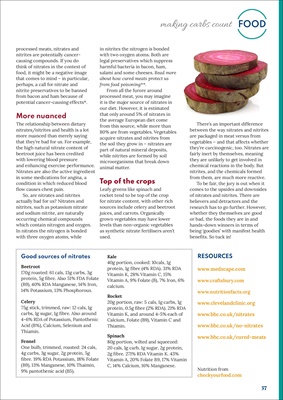
37
making carbs count FOOD
processed meats, nitrates and
nitrites are potentially cancercausing
compounds. If you do
think of nitrates in the context of
food, it might be a negative image
that comes to mind - in particular,
perhaps, a call for nitrate and
nitrite preservatives to be banned
from bacon and ham because of
potential cancer-causing effects*.
More nuanced
The relationship between dietary
nitrates/nitrites and health is a lot
more nuanced than merely saying
that they're bad for us. For example,
the high natural nitrate content of
beetroot juice has been credited
with lowering blood pressure
and enhancing exercise performance.
Nitrates are also the active ingredient
in some medications for angina, a
condition in which reduced blood
flow causes chest pain.
So, are nitrates and nitrites
actually bad for us? Nitrates and
nitrites, such as potassium nitrate
and sodium nitrite, are naturally
occurring chemical compounds
which contain nitrogen and oxygen.
In nitrates the nitrogen is bonded
with three oxygen atoms, while
RESOURCES
www.medscape.com
www.craftsbury.com
www.nutritionfacts.org
www.clevelandclinic.org
www.bbc.co.uk/nitrates
www.bbc.co.uk/no-nitrates
www.bbc.co.uk/cured-meats
in nitrites the nitrogen is bonded
with two oxygen atoms. Both are
legal preservatives which suppress
harmful bacteria in bacon, ham,
salami and some cheeses. Read more
about how cured meats protect us
from food poisoning**.
From all the furore around
processed meat, you may imagine
it is the major source of nitrates in
our diet. However, it is estimated
that only around 5% of nitrates in
the average European diet come
from this source, while more than
80% are from vegetables. Vegetables
acquire nitrates and nitrites from
the soil they grow in - nitrates are
part of natural mineral deposits,
while nitrites are formed by soil
microorganisms that break down
animal matter.
Top of the crops
Leafy greens like spinach and
rocket tend to be top of the crop
for nitrate content, with other rich
sources include celery and beetroot
juices, and carrots. Organically
grown vegetables may have lower
levels than non-organic vegetables
as synthetic nitrate fertilisers aren't
used.
There's an important difference
between the way nitrates and nitrites
are packaged in meat versus from
vegetables - and that affects whether
they're carcinogenic, too. Nitrates are
fairly inert by themselves, meaning
they are unlikely to get involved in
chemical reactions in the body. But
nitrites, and the chemicals formed
from them, are much more reactive.
To be fair, the jury is out when it
comes to the upsides and downsides
of nitrates and nitrites. There are
believers and detractors and the
research has to go further. However,
whether they themselves are good
or bad, the foods they are in and
hands-down winners in terms of
being 'goodies' with manifest health
benefits. So tuck in!
Good sources of nitrates
Beetroot
170g roasted: 61 cals, 13g carbs, 3g
protein, 5g fibre. Also 51% FDA Folate
(B9), 40% RDA Manganese, 14% Iron,
14% Potassium, 13% Phosphorous.
Celery
75g stick, trimmed, raw: 12 cals, 1g
carbs, 1g sugar, 1g fibre. Also around
4-6% RDA of Potassium, Pantothenic
Acid (B%), Calcium, Selenium and
Thiamin.
Fennel
One bulb, trimmed, roasted: 24 cals,
4g carbs, 3g sugar, 2g protein, 5g
fibre. 19% RDA Potassium, 18% Folate
(B9), 13% Manganese, 10% Thaimin,
9% pantothenic acid (B5).
Kale
40g portion, cooked: 10cals, 1g
protein, 1g fibre (4% RDA). 31% RDA
Vitamin K, 28% Vitamin C, 15%
Vitamin A, 9% Folate (B), 7% Iron, 6%
calcium.
Rocket
20g portion, raw: 5 cals, 1g carbs, 1g
protein, 0.5g fibre (2% RDA). 21% RDA
Vitamin K, and around 4-5% each of
Calcium, Folate (B9), Vitamin C and
Thiamin.
Spinach
80g portion, wilted and squeezed:
20 cals, 1g carb, 1g sugar, 2g protein,
2g fibre. 271% RDA Vitamin K. 43%
Vitamin A, 20% Folate B9, 17% Vitamin
C, 14% Calcium, 16% Manganese.
Nutrition from
checkyourfood.com